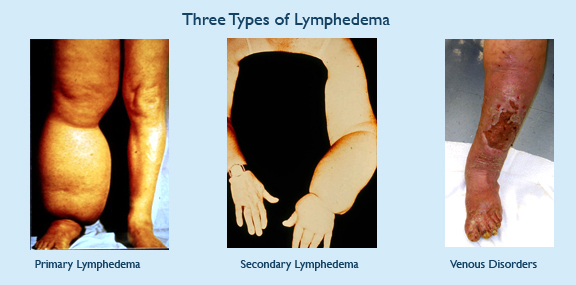What is Lymphedema:
Lymphedema is a disorder of the human lymphatic circulation. It is marked by
the accumulation of lymph fluid, often in
the form of swelling of the arms or legs. This occurs when lymph vessels or lymph nodes are blocked
or surgically
removed
When the lymph system is so impaired the lymph fluid exceeds the lymphatic
systems transport
capacity. This can cause an
abnormal amount of protein fluid to collect in the surrounding tissue. Untreated, this stagnant,
protein rich fluid not
only causes tissue channels to increase in size, but also reduces oxygen though the transport
system. This can interfere
with wound healing, and provides a breeding ground for bacteria that can result in various
infections. A chronic
inflammatory condition stemming from this accumulation of fluid may result in fibrosis, ( hardening
) of the extremity
tissues.
What kinds of Lymphedema are there:
Lymphedema can be broken down into three types

1. Primary Lymphedmea is seen as a Congenital Abnormality, sometimes
known as Milroy's Disease. It
usually strikes
anytime during childhood, and up into the early twenties. There is no cure for this disease. It can
however, be managed
through therapy..
2. Secondary Lymphedmea is the most common type of Lymphedmea. It results
from damage to the Lymph Nodes or the Lymph
system. The most well known secondary Lymphedema is Post-Mastectomy Lymphedema. It can happen after
surgery or radiation
treatments for breast cancer, cervical cancer, rectal cancer, or anal cancer.
3. Venous Disorders are considered a type of Lymphedmea. Chronic Venous
Insufficiency is a common problem. It occurs
because of partial vein blockage or blood leakage around the valves of the veins. It can lead to
Venosu Ulcers, Deep
Vein Thrombosis in the legs, and Celluittus Infections.
The Treatments for Lymphadema are as follows:
1. Elevation: This means keeping the limb elevated, usually above the level of the heart. This
allows gravity to
facilitate the drainage of fluid from the limb. This elevation method usually takes a great deal
of time to see results.
On the plus side, it requires no special training, and can be done anytime, or place that you
can elevate the arm. It
requires no special equipment or insurance coverage.
2. Lymphatic massage: There are a number of different techniques used for
what is known as manual lymph drainage. Forms
of massage have been used for over 100 years. This involves a trained therapist who will massage
the arm, gently pushing
the lymph fluid back up into the body. Therapist can be trained in a variety of methods to drain
the arm with this
technique. ie. the Vodder method, or the Leduc school. A trained therapist can teach you how do
this some of these
techniques yourself. As in all therapies, lymphatic massage requires dedication. It must be done
on a daily basis.
Insurance coverage varies for massage when done by a professional therapist. Some plans limit
just how many times you
can see a therapist in a year. Check your individual plan for details.
3. Compression Garments: These are used to help maintain limb size. The
garments can be off the shelf, or custom made
for the individual. The garments can cover all of the limb, or just parts of it. The compression
strength can also vary.
The heavier the compression, the more effective the stocking. The heavier the compression
though, the more difficult the
stocking will be to put on and wear. These stockings need to be replaced every six months. As
the compression lessens
and the garment does less and less.
4. Pneumatic Compression Pumps and Sleeves: These are air-filled
appliances that fits over the swollen limb. Pneumatic
pumps have been used since the 1950s. Notably, at the renown Mayo Clinic. The sleeve fills up
with air that gently
massages the stagnant fluid back up towards the body. There are several types of these pumps
that have various
advantages over others. Some have the ability to adjust the pressure over specific areas of the
limb. The best pumps
have what is known as gradient compression, meaning more pressure at the most distant location,
and less pressure closer
to the body. These pumps are easy to use, and are usually covered by insurance.
Most physicians, and therapist recommend a combination of these therapies
to deal with Lymphedema. A recent study from
the Stanford University Lymphedema Center showed that a combination therapy program of massage,
and the pump was
superior to individual methods of treatment.



